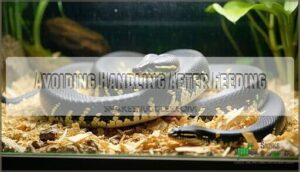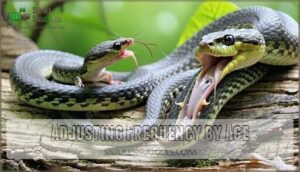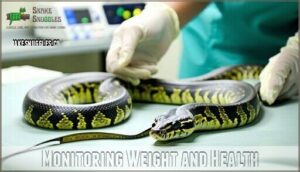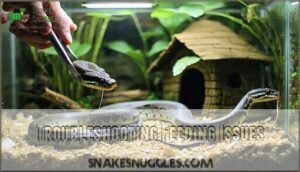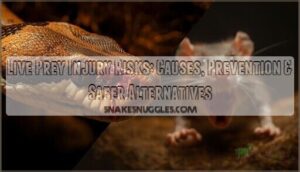This site is supported by our readers. We may earn a commission, at no cost to you, if you purchase through links.
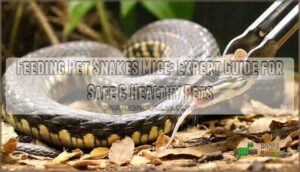
You’ll thaw the frozen mouse to room temperature, then use feeding tongs to offer it to your snake. The mouse should match your snake’s thickest body section, and young snakes need meals more often than adults.
Create a quiet environment during feeding time, and don’t handle your snake for 48 hours afterward to prevent regurgitation. Most snakes eat every 1-2 weeks, but this varies by species and age.
Getting the basics right prevents common feeding problems that even experienced keepers sometimes overlook, ensuring a safe and healthy environment for your pet snake, which is crucial for its overall well-being and requires careful consideration of its feeding schedule.
Table Of Contents
- Key Takeaways
- Choosing Snake Food
- Feeding Techniques
- Snake Diet Requirements
- Feeding Frequency Guidelines
- Troubleshooting Feeding Issues
- Frequently Asked Questions (FAQs)
- Should you feed a pet snake live mice?
- How often do snakes need to eat mice?
- Can I feed my snake to mice?
- Is it okay to feed snakes frozen mice?
- How often should I clean my snakes water bowl?
- What temperature should thawed mice be before feeding?
- How long can thawed mice sit out safely?
- Should I remove uneaten food from the enclosure?
- Conclusion
Key Takeaways
- Choose frozen mice over live prey – they’re safer for your snake since they eliminate bite and scratch injuries while providing the same nutrition
- Match prey size to your snake’s girth – the mouse should be roughly the same width as your snake’s thickest body section to prevent choking or underfeeding
- Wait 48 hours after feeding before handling – disturbing your snake during digestion can cause dangerous regurgitation and stress
- Adjust feeding frequency by age – young snakes need meals every 5-7 days, while adults only require feeding every 10-14 days
Choosing Snake Food
Selecting the right food for your snake isn’t just about grabbing any mouse from the pet store—it’s about understanding your snake’s specific needs and safety requirements.
You’ll need to verify whether to choose frozen or live prey, make certain of proper nutritional balance, and match the prey size to your snake’s body dimensions to ensure a safe feeding experience.
Frozen Vs Live Prey
When choosing between frozen and live prey, frozen mice win hands down.
Live prey risks injuring your snake through bites and scratches, while frozen prey eliminates these dangers completely.
Frozen options are safer, more convenient, and ethically sound since prekilled mice avoid animal suffering.
Most snakes adapt well to frozen vs live feeding, making this the smart choice for responsible snake owners.
This also removes the risk of inflicting defensive wounds on your pet.
Nutritional Considerations
Beyond choosing between frozen and live prey, you’ll want to understand what makes a nutritionally complete meal for your snake. Proper snake nutrition isn’t just about filling their belly—it’s about providing the right fuel for their unique reptile nutrition needs.
Here’s what affects your snake’s nutritional value:
- Prey Composition – Whole rodents deliver complete amino acid profiles your snake can’t get elsewhere
- Mineral Balance – Calcium and phosphorus ratios in rodent diet directly impact bone health
- Vitamin Supplementation – Wild prey naturally contains vitamins that support immune function
- Hydration Needs – Fresh prey provides essential moisture content for proper digestion
- Gut Loading – Well-fed rodents pass better nutritional needs to your snake
Think of it like this: a mouse isn’t just meat—it’s a complete nutritional package. The bones provide calcium, organs deliver vitamins, and muscle tissue supplies protein. This natural balance makes whole prey far superior to processed alternatives for meeting your snake’s complex nutritional requirements.
Prey Size Selection
Match prey size to your snake’s girth, not length. The mouse should be roughly the same width as your snake’s thickest part.
Pinky mice work for hatchlings, while fuzzy mice suit juveniles. Large snakes need adult mice or multiple prey items to avoid underfeeding.
Too big risks impaction; too small leaves them hungry.
Feeding Techniques
How you feed your snake matters just as much as what you feed it. Using proper techniques protects both you and your pet while making mealtime stress-free.
Using Tongs or Forceps
Use metal feeding tongs or forceps when offering frozen mice to your snake.
The tongs material should resist bites, while forceps design provides better grip strength for secure prey presentation.
Consider various feeding tools for different snake sizes.
Hold the mouse behind its head and wiggle gently to trigger your snake’s strike response.
This technique keeps your fingers safe while reducing stress during feeding snakes, making the process smoother for both you and your pet, using secure prey presentation.
Creating a Calm Environment
Your snake’s stress levels drop substantially when you create the right feeding atmosphere. Think of it like setting the stage for a performance—everything needs to be just right. A quiet space with dim lighting helps your snake feel secure and ready to eat naturally.
**Set the stage right—your snake’s feeding success depends on creating the perfect hunting atmosphere.
- Reduce stress by feeding during evening hours when snakes are most active
- Dim lighting creates a natural hunting environment that encourages feeding behavior
- Quiet space away from foot traffic and household noise prevents distractions
- Minimize movement around the secure enclosure during feeding time
- Secure enclosure with proper hides gives your snake confidence to feed openly
The calmer your snake feels, the better its snake feeding habits will develop. Proper setup may include using a reptile dimming light to simulate natural conditions. Watch how your snake’s feeding behavior improves when you respect its need for privacy and security during meals.
Avoiding Handling After Feeding
After you’ve set up the perfect feeding environment, resist the urge to handle your snake.
Wait at least 48 hours after feeding to prevent digestion disruption and regurgitation risks.
Moving or disturbing your snake during this critical period can cause stress and potentially dangerous regurgitation.
This patience guarantees proper digestion, reduces stress, and prevents injury to both you and your pet during vulnerable feeding recovery.
Snake Diet Requirements
Your snake’s diet needs depend on its species, age, and activity level.
What works for a ball python won’t necessarily work for a corn snake, and a growing juvenile needs different nutrition than an adult couch potato.
Species Specific Diets
Before feeding your snake, understand that dietary needs vary dramatically between specific species.
While most pet snakes thrive on mice, some require alternative prey to meet their nutritional requirements.
Different snake species have evolved unique dietary requirements:
- Boas and pythons – primarily eat warm-blooded prey like mice and rats
- Garter snakes – need amphibians and fish alongside rodents
- Egg-eating snakes – require bird eggs exclusively
- Ringneck snakes – consume invertebrates and earthworms
Without proper prey variety, nutritional deficiencies can develop, leading to serious health issues in your pet.
A balanced diet requires understanding snake nutritional requirements to avoid such issues.
Age and Size Considerations
Your young snake’s appetite changes dramatically as it grows, much like a teenager raiding the refrigerator! Hatchling diets require frequent meals every 5-7 days with pinkie mice.
Juvenile portions shift to fuzzy mice weekly, while adult frequency drops to every 10-14 days with adult mice. Geriatric needs may require softer prey and adjusted schedules.
Size impact determines everything – match prey width to your snake’s thickest body section for proper portion control.
| Snake Age | Prey Size | Feeding Schedule |
|---|---|---|
| Hatchling | Pinkie mice | Every 5-7 days |
| Juvenile | Fuzzy/hopper mice | Weekly |
| Adult | Adult mice/small rats | Every 10-14 days |
| Senior | Appropriate to size | Monitor condition |
| All ages | Match snake’s girth | Adjust as needed |
Activity Level and Metabolism
Active snakes burn more calories and need frequent feeding, while sluggish species require less.
Think of your snake like a sports car versus a pickup truck—each burns fuel at their own pace.
Your snake’s energy expenditure directly affects its feeding frequency and metabolism.
Basking behavior, seasonal changes, and shedding impact digestion rate too.
High-energy hunters need meals every 5-7 days, but slow-moving constrictors can wait 2-3 weeks.
Monitor your snake’s activity to create the perfect feeding schedule.
Feeding Frequency Guidelines
Getting the feeding schedule right is essential for your snake’s health and happiness.
You’ll need to adjust how often you feed based on your snake’s age, monitor their weight regularly, and avoid the common pitfalls of overfeeding or underfeeding, which is crucial for their overall happiness.
Adjusting Frequency by Age
Beyond the hatchling stage, your snake’s feeding frequency changes dramatically with age.
Baby snakes need meals every 5-7 days during rapid growth spurts, while juveniles move to weekly schedules.
Adult maintenance typically requires feeding every 10-14 days, though senior adjustments may extend this further.
You’ll notice these natural shifts as your snake matures and its metabolism slows down accordingly, which is a key aspect of its maintenance.
Monitoring Weight and Health
Regular weight checks help you spot problems before they become serious.
Your snake’s body condition score reveals if you’re hitting the sweet spot between too much and too little food.
Watch for these warning signs:
- Visible ribs or spine – your snake’s crying out for more nutrition
- Thick, sausage-like body – overfeeding’s taking its toll on their health
- Dull, stuck shed – poor shedding health signals nutritional problems
- Cloudy eyes lasting weeks – dehydration affects their whole system
- Wheezing or mouth breathing – respiratory issues need immediate attention
Monitor hydration levels through skin elasticity and regular fecal analysis for parasites.
You can also adjust feeding based on individual metabolic needs.
Preventing Overfeeding and Underfeeding
Finding the sweet spot between too much and too little food keeps your snake healthy and happy.
Watch for weight changes and body condition – a well-fed snake won’t look like a tube with a tennis ball inside.
Growth rates slow with age, so adjust schedules accordingly.
Overfeeding leads to obesity while underfeeding causes malnutrition. Monitor prey calorie intake and your snake’s appearance regularly to prevent these issues and ensure your snake remains healthy.
Troubleshooting Feeding Issues
Even the most well-cared-for snakes sometimes refuse their meals, leaving you wondering what went wrong.
Recognizing the difference between normal feeding behavior and potential health issues can help you take the right steps to get your snake back on track.
Snake Rejecting Food
When your snake turns its nose up at dinner, don’t panic—food rejection happens.
Shedding issues, stress factors, or temperature problems often trigger picky eaters. Try switching prey variety, checking your heat gradient, or reducing handling.
Some snakes fast for months without harm. Addressing snake eating issues can be complex.
Snake feeding problems usually resolve once you identify whether it’s environmental stress or natural behavior causing reluctant eaters.
Recognizing Health Problems
Watch for telltale signs that something’s wrong with your snake’s health.
Weight loss, regurgitation signs, and lethargy indicators often point to snake feeding problems.
Abnormal shedding patterns, scale rot, or unusual behavior can signal deeper health issues.
One key indicator can be changes in shedding, which may point to underlying issues.
Your snake’s feeding response tells you a lot about its overall condition—healthy snakes strike with purpose.
Consulting a Veterinarian for Advice
Professional snake feeding veterinarian consultation becomes necessary when home remedies fail.
Expert diet plans and supplement needs vary by species, requiring specialized care beyond basic feeding guidelines.
Veterinarians provide health monitoring protocols and preventative strategies personalized to your snake’s unique requirements.
They’ll assess reptile health thoroughly, identifying snake feeding health risks you might miss, ensuring your pet thrives long-term.
Frequently Asked Questions (FAQs)
Should you feed a pet snake live mice?
You shouldn’t feed live mice to your pet snake. Frozen-thawed mice are safer, eliminating injury risks from bites and reducing disease transmission while providing identical nutrition.
How often do snakes need to eat mice?
Young snakes eat weekly, while adults feed every 2-4 weeks.
You’ll adjust based on your snake’s age, size, and species.
Juveniles grow fast and need more frequent meals than laid-back adults, this can be considered a complete concept to understand the feeding needs.
Can I feed my snake to mice?
No, you can’t feed your snake to mice.
Snakes eat mice, not the other way around.
Use proper-sized frozen or live mice for your snake’s meals based on its species and size requirements.
Is it okay to feed snakes frozen mice?
Yes, frozen mice are perfectly safe and actually recommended for feeding your snake.
They’re safer than live prey, eliminate injury risks, and retain over 90% of their nutritional value when properly thawed.
How often should I clean my snakes water bowl?
Clean water’s your snake’s lifeline, but timing matters.
Change it weekly or immediately when you spot debris, shed skin, or cloudiness.
Fresh water prevents bacteria buildup and keeps your slithery friend healthy and hydrated.
What temperature should thawed mice be before feeding?
Thawed mice should reach room temperature or slightly warmer before feeding. You’ll want them around 80-90°F to trigger your snake’s feeding response effectively.
How long can thawed mice sit out safely?
Thawed mice shouldn’t sit out for more than 30 minutes at room temperature. After that, bacteria can multiply rapidly, creating health risks for your snake. Refrigerate leftovers immediately or discard them.
Should I remove uneaten food from the enclosure?
Remove uneaten food immediately after 24 hours to prevent bacterial growth and odors. Leaving rotting prey creates health risks and attracts pests, making your snake’s environment unsafe and unpleasant.
Conclusion
Sarah’s ball python refused to eat for three weeks until she realized the mouse was too large—switching to an appropriately sized prey item solved the problem immediately.
Mastering feeding pet snakes mice requires attention to detail, from selecting the right prey size to maintaining proper feeding schedules.
You’ll find success by using frozen mice, creating calm feeding environments, and monitoring your snake’s health closely.
Remember that patience and consistency are key when establishing feeding routines that keep your snake healthy and thriving.
- https://abdragons.com/blog/frozen-mice-and-rats-for-snake-feeding/
- https://www.rodentpro.com/informationcenter/resources/feeding-frozen-vs-live-reptiles
- https://omgsnakes.com/post/159208440096/why-is-feeding-snakes-frozen-mice-better-for-them
- https://www.crittercontrol.com/wildlife/snakes/snake-diet/
- https://vcahospitals.com/know-your-pet/snakes-feeding



